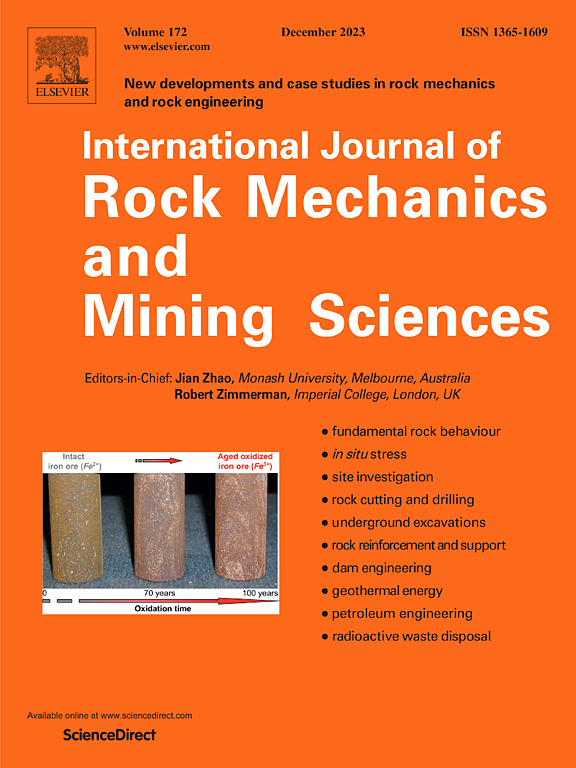泰国Mae Moh矿岩质边坡稳定性及继电器坡道控制破坏机制的水-力耦合评价
IF 7
1区 工程技术
Q1 ENGINEERING, GEOLOGICAL
International Journal of Rock Mechanics and Mining Sciences
Pub Date : 2025-04-28
DOI:10.1016/j.ijrmms.2025.106132
引用次数: 0
摘要
泰国Mae Moh矿复杂的构造历史造就了正断层,正断层形成了一个控制c1 -西盘大块块体破坏机制的传递坡道。2021 - 2023年岩土工程监测数据表明,边坡变形主要受采矿活动和降水的影响,这是由水-力耦合过程引起的。采用三维离散元模型计算了2023年、2034年和2041年三种方案的位移和安全系数。模拟场景包括干燥条件、地下水位有效应力分析和HM耦合分析。数值分析揭示了双平面复合块体滑动、双平面旋转块体滑动以及受接力坡道倾斜影响的趾部上推等破坏机制。从HM耦合分析中获得的最大位移和FS比传统方法得出的结果更为关键,特别是在2041年,开挖形成了一个完全露天的采空区。此外,敏感性分析表明,当地下水位达到临界值时,将发生失稳。监测数据和数值模型表明,卸荷引起的应力松弛扰动导致结构面渗透性增加,导致开采过程中对地下地下水变化敏感的边坡稳定性。这些发现强调了HM耦合过程对边坡稳定性的显著影响,并强烈建议将HM耦合方法纳入边坡设计,以实现更具代表性和保守性的风险评估。本文章由计算机程序翻译,如有差异,请以英文原文为准。

Rock slope stability and hydromechanical coupling evaluation on the relay ramp-controlled failure mechanism in Mae Moh Mine, Thailand
The complex tectonic history of the Mae Moh mine in Thailand created normal faults, which formed a relay ramp that controlled the failure mechanism of the massive block in the C1-west wall. Geotechnical monitoring data between 2021 and 2023 revealed that the slope deformation was predominantly influenced by mining activities and precipitations, resulting from the hydromechanical (HM) coupling process. A 3D-distinct element model was performed to calculate displacement and the factor of safety (FS) of the mine plans in 2023, 2034 and 2041. The modeling scenarios consisted of dry condition, water table with effective stress analysis, and HM coupling analysis. The numerical analysis revealed the failure mechanisms, including bi-planar compound block sliding, bi-planar rotational block sliding, and toe pushing-up influenced by the dipping of the relay ramp. The maximum displacement and FS obtained from the HM coupling analysis were found to be more critical than those derived from the traditional methods, particularly in 2041, where the excavation created a fully open-pit wall face. Additionally, the sensitivity analysis indicated the instability if the groundwater level reaches the critical value. The monitoring data and numerical model identified that disturbances from stress relaxation due to unloading led to increased permeability in discontinuities, causing slope stability sensitive to changes in the subsurface groundwater during mining activities. These findings emphasize the significant effect of the HM coupling process on slope stability and highly recommend integrating the HM coupling approach into slope design to achieve a more representative and conservative risk assessment.
求助全文
通过发布文献求助,成功后即可免费获取论文全文。
去求助
来源期刊
CiteScore
14.00
自引率
5.60%
发文量
196
审稿时长
18 weeks
期刊介绍:
The International Journal of Rock Mechanics and Mining Sciences focuses on original research, new developments, site measurements, and case studies within the fields of rock mechanics and rock engineering. Serving as an international platform, it showcases high-quality papers addressing rock mechanics and the application of its principles and techniques in mining and civil engineering projects situated on or within rock masses. These projects encompass a wide range, including slopes, open-pit mines, quarries, shafts, tunnels, caverns, underground mines, metro systems, dams, hydro-electric stations, geothermal energy, petroleum engineering, and radioactive waste disposal. The journal welcomes submissions on various topics, with particular interest in theoretical advancements, analytical and numerical methods, rock testing, site investigation, and case studies.

 求助内容:
求助内容: 应助结果提醒方式:
应助结果提醒方式:


